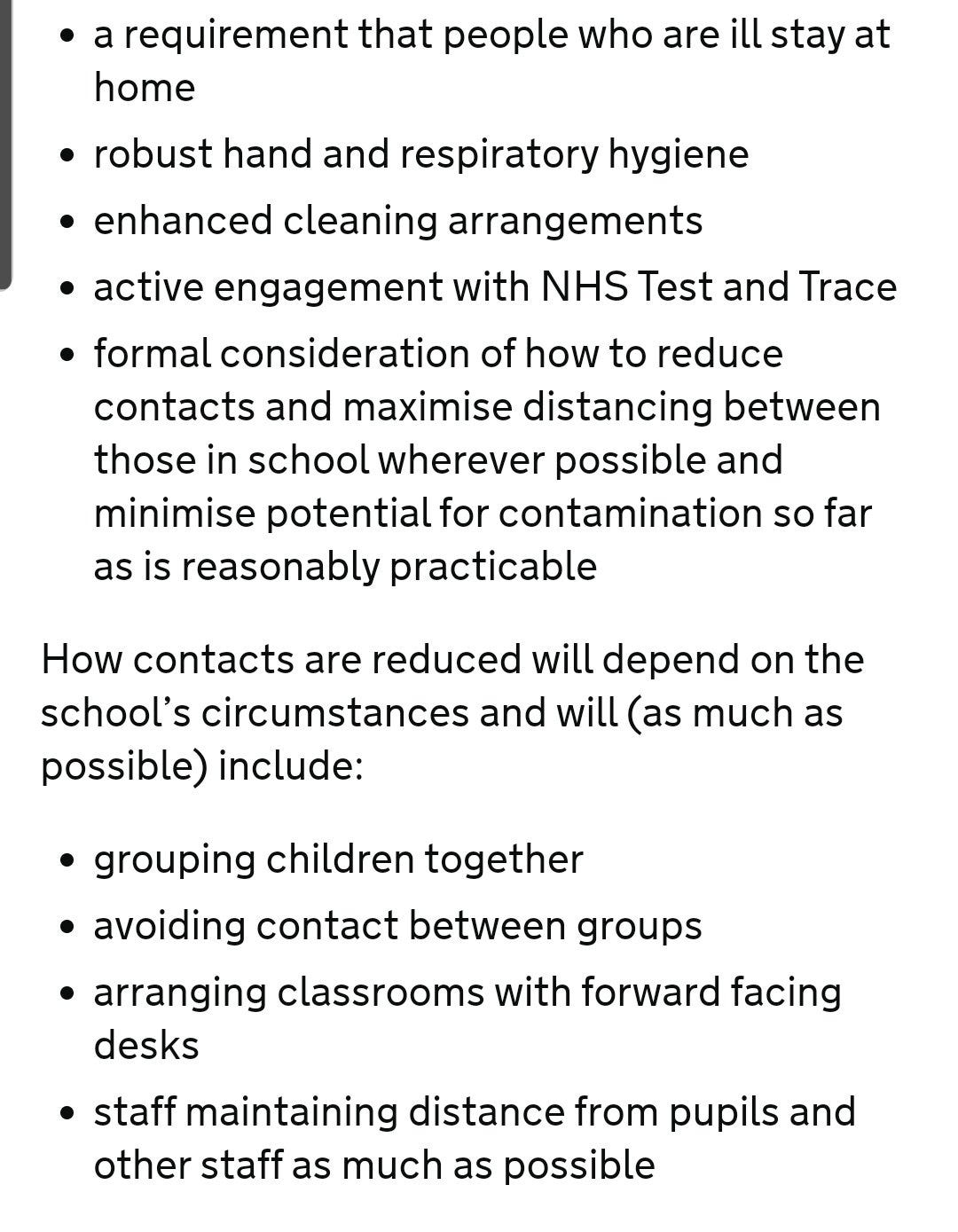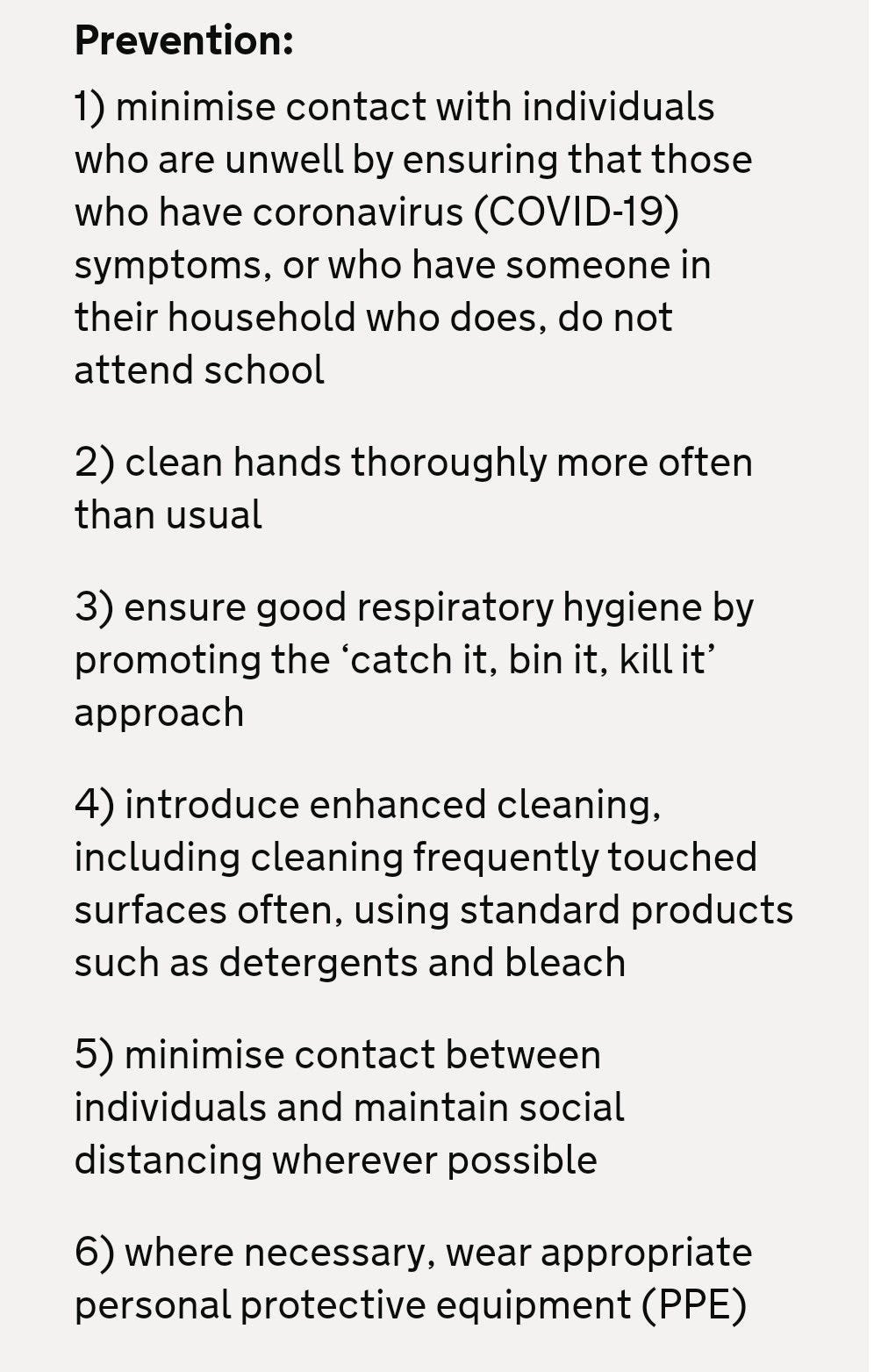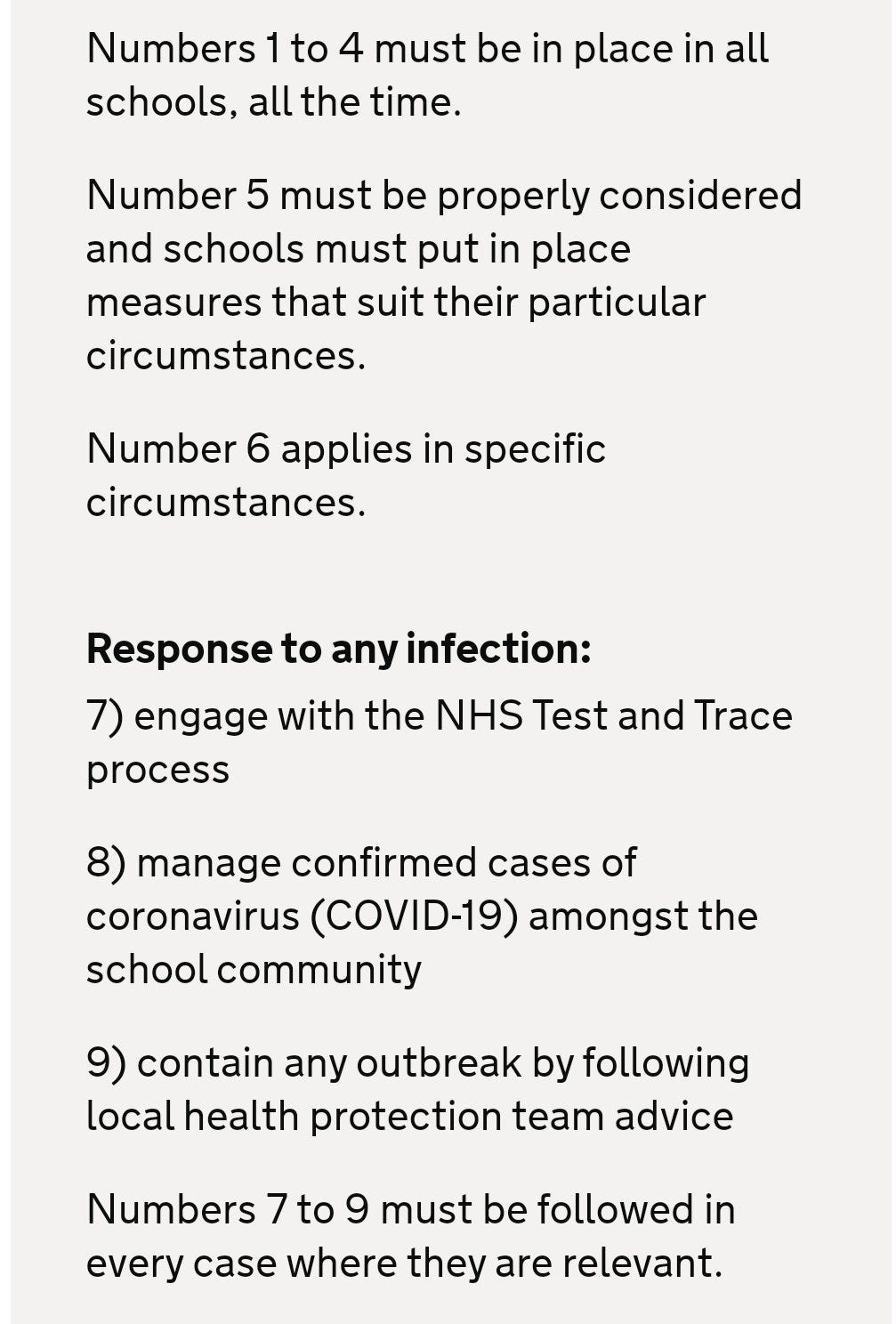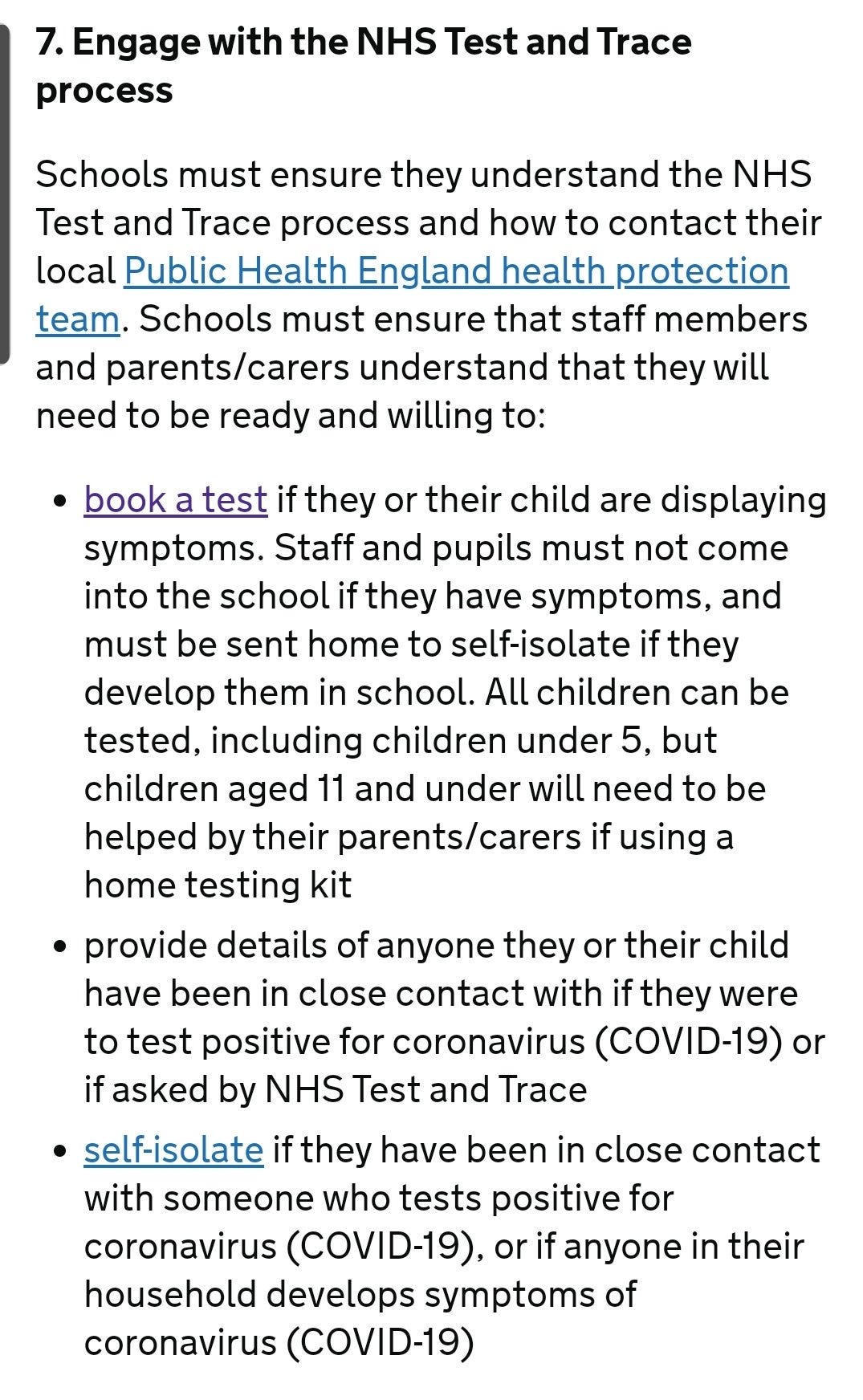The UK Government failed to explain how the guidance for schools in June 2020 and September 2020 was written. In June the Government wasn’t following SAGE’s advice as the cabinet made changes to the roadmap that hadn’t been modelled by SAGE.
When guidance was issued for the start of September it was again at odds with the recommendations for cutting transmission in SAGE's minutes, it seems the government either ignored SAGE because they didn’t believe them or because they were willing to accept higher transmission rates in children.
Who wrote the September 2020 schools guidance has been a matter of debate since a FOI request failed to provide an answer.
The FOI asked for “minutes of all meetings Education Secretary Gavin Williamson, Schools Minister Nick Gibb or Education Select Committee Chair Robert Halfon attended where the Department for Education guidance to schools document was discussed prior to its release in August 2020”, the same request was made regarding the June 2020 guidance.
The response read
“Following a search of the Department’s paper and electronic records, I have established that the information you requested is not held by the Department. Specific discussions or meetings did not take place on the guidance for schools. However, discussions took place on wider education issues which civil servants used in their policy formation.”
The DfE didn’t write the guidance, they didn’t even discuss it, so where did it come from?
17 May I was contacted by a reliable source inside the DfE regarding the changes to the roadmap discussed in part 5 of this review.
“DfE have been bounced into doing this (schools return etc). They weren’t expecting it so they weren’t prepared for it, and they don’t want to do it at this time. But the Treasury (being senior) has pushed them into it (return to work, save some money etc - despite today’s announcements) Said made it clear they couldn’t support talk re a return any earlier (there was pressure on this) as the supporting data (deaths/infections) were nowhere near by government’s own criteria. They’re keeping fingers crossed things change there significantly. Feels there is much confusion and much nervousness around policy being arrived at in a rushed way.”
I received similar messages regarding the DfE having no control over its own policy at other points later in the pandemic from various sources inside or working with the government.
Children's Task and Finish Group
The CTF, a sub group of SAGE (details in part 4 of this review) met on 8 July to discuss schools returning in September.
The CTF set out the need to balance the risks from covid against the risks of children not returning. It’s worth noting that the education unions were not opposing a return in September, the ongoing debate in July was in regards to how students would return and what measures were needed to protect health and reduce disruption from outbreaks.
CTF claim they have moderate confidence that children are less susceptible to being infected. The main evidence in regards to this are studies produced by Russell Viner who was also a member of the CTF.
The CTF states “In contrast, and covered further in previous SAGE/SPI-B advice (1) , the harms to student mental health and development of keeping educational settings closed are well established(2)”.
Reference 1 is a document from mid April that covers the harms that are predicted whilst explaining that at the time an evidence base of data didn’t exist.
Reference 2 is the document produced in the CTF meeting on 20 May, this also contains predictions of harms but no data from the pandemic.
While lockdown will have caused harm to a number of children, the scale was unknown, the CTF has not provided the evidence to be able to claim their understanding of the harms is “well established.” Even in 2023 with more time and data its been difficult to establish what harm is directly attributable to lockdown and measures compared to the wider factors at play during the pandemic. Mental health issues for example are complex and multifaceted.
The CTF go on to restate that children may be less infectious and play a lesser role in transmission, they also state that “there is little direct evidence of transmission from pupils to teachers”. This is likely referencing the RCPCH/Don’t Forget the Bubbles review of data from China that was quoted in the press alongside the claim there was no evidence of a child infecting an adult (covered in Review Part 2). Staff are considered to be more at risk from each other than a classroom full of students.
The CTF also claim that “In countries where schools have been open for some time, data suggests that school opening has made little difference to community transmission.” However this ignores the case of Israel that directly attributed schools a considerable rise in cases with schools, it also does not take into account how schools reopened in other countries, many of which at this time had returned with reduced class sizes.
On masks the CTF say
“The use of facemasks for children is likely to be unfeasible for younger children. Among older children there are still risks that this will increase face touching and risk substitution, but these may be mitigated through education. Given the low risk of transmission between children, the detrimental developmental impacts of extended face mask use by children (including affecting damage to general speech and language development) may be greater than the potential protective benefit of facemask use.”
By this point in the document moderate confidence children are less infectious is now being stated as if it is a fact. Considering the CTF has dismissed masks for younger children are they then weighing up language development as a potential harm against teenagers wearing masks?
Bubbles were suggested as potentially being effective, however the CTF then gave reasons not to have bubbles. Advice on co-constructing advice with stakeholders wasn’t followed by the DfE.
The recent systematic review cited as finding children were 56% less likely to be infected than adults had Viner as the first named author.
The CTF chose three studies from among many international studies to highlight.
The CTF set out potential measures that could be introduced but then under the next section Behavioural Considerations considers which measures could be implemented.
The dismissal of rotas focuses on their use as a way of keeping students off long enough for symptoms to develop, the use of rotas for allowing social distancing and reducing contacts with smaller class sizes is not fully considered.
What is interesting is the comment that there is ”minimal benefit of rotas…if children mix extensively between rota groups outside of school, as may be the case under the current measures” which contradicts the narrative of immunity debt that appeared in mid 2021. This acknowledges that children were not “locked down for two years” as has been claimed by much of the media and some of the government’s advisers including Viner and other senior paediatricians from the RCPCH. For instance the newspapers that promoted the concept of immunity debt were filled with pictures of packed parks and beaches throughout the summer of 2020.
By July 2020 everyone was expected to wear masks on buses, however the CTF suggest that it might not be necessary for children to wear masks due to the “potential low transmission of children.”
The CTF Annexes cites two sources.
Annex A
Once again policy is being based on a few sources of weak evidence by the same individuals. Viner’s substantial influence on the UK’s evidence base is undeniable. This continues with another paper published by Viner on 21 July.
In July 2020 Russell Viner was a co-author of a paper titled. “An evidence-based theory of change for reducing SARS-CoV-2 transmission in reopened schools”. This appears to be the basis for the DfE’s school guidance as the measures recommended are almost identical as is much of the phrasing.
The paper begins by suggesting children are less likely to be infected, however this is caveat-ed.
The introduction states the need for measures to cut transmission.
The importance of convincing parents schools are “safe enough” is highlighted, this includes “updates in the face of emerging evidence about the role of children and schools in transmission”, which the authors believe shows that infection is less likely in children.
This should be considered an influential paper as the authors were advising the UK government and international bodies.
Note there is considerable focus on formites, aerosols being exhaled are mentioned alongside droplets. There is reference to hand driers generating aerosols reminiscent of when Public Health said PPE was only required for “aerosol generating procedures”.
Under engineering solutions its recognised that schools have poor ventilation, however measures to improve air quality that require investment is not considered, simply opening windows and doors “where feasible” is the only suggestion provided. Once again there is a disproportionate focus on formites and droplets despite understanding of aerosols being better understood by July 2020.
The focus on droplets let to some quiet bizarre suggestions such as telling children they shouldn’t raise their hands above their shoulders, I assume this is so that formites can’t fall a further distance away from the person. Expecting people to cough or sneeze into a tissue or elbow as an effective mitigation demonstrates how far behind understanding was compared to countries like Japan which at the time were showing videos of aerosol spreading out and lingering on national news broadcasts.
Viner and his coauthors acknowledge the effectiveness of respirators, however supply is given as the main reason not to recommend them to school staff. This does also raise the question of why respirators were not recommended when masks were finally introduced into schools in February 2021 considering by this point they were cheap and readily available. There is also the question of why Viner appeared frequently in the media late 2020 and early 2021 claiming that there was no evidence on the effectiveness of masks.
DfE September Guidance
Considering the FOI responses and committee meetings it would appear the DfE guidance was drawn up by the Cabinet Office, or specifically the “quad” of Johnson, Sunak, Hancock and Raab. Gavin Williamson as Education Secretary appears to have had little input while Viner appears to be a key individual on schools policy considering his work with SAGE, the CTF, Public Health and the RCPCH, and how often his papers are cited and how closely they resemble the final guidance.
With many measures dismissed and questioned, the final guidance was even more relaxed than what was suggested by the various committees. SAGE’s warnings regarding schools increasing transmission were almost entirely ignored beyond the need for a TTI system.
The guidance stated that there was a “comprehensive hierarchy of controls” however besides bubbling and more access to testing there was little difference between how schools returned in September and how they were operating in March when herd immunity was the strategy, The guidance makes repeated use of terms like “so far as is reasonably practicable” and “as much as possible” meaning that in many schools measures like social distancing weren’t implemented.
Essentially schools were told, “here's some ideas, do what you can”.
Specific circumstances for wearing masks were limited to “where personal care is administered” for instance in Special Educational settings.
The definition of close contacts in schools were clearly based on transmission by droplets not aerosols, even considering just droplets there were obvious inconsistencies that led to accusations of hygiene theatre by sceptics and the covid cautious alike which undermined trust in government institutions.
This guidance led to teachers being told that if they stayed 2 metres away from students they couldn’t be a close contact regardless of how much time they spent in a classroom with multiple students that then tested positive, even in a room which had no windows. By staying two metres away teachers were then allowed in many schools to move between bubbles. It seems that the idea behind this was to prevent education workers having to isolate in the short term, even if this resulted in more transmission in the longer term. Schools running out of staff was often the cause for school closures.
This was particularly problematic for clinically vulnerable staff due to the rules for shielding changing in the summer, the advice for school workers was to maintain their distance “where possible”. N95/FFP2 respirators were not recommended for these workers and it came down to union reps negotiating at individual school in order to protect CEV and CV staff. The official line from government was that the “hierarchy of controls” provided adequate protection.
The assumption that children were less likely to be infected led to staff being blamed for outbreaks in education, the science behind this stance was less important than the headlines that this generated. Public perception in the political debate became more important than the underlying science.
Summary
The guidance appears to have relied heavily on Viner’s claims that children were less likely to be infected, were less likely to infect adults and that schools did not play a significant role in transmission.
Despite growing evidence around aerosol transmission the September guidance focused primarily on formites and droplets. There was a negligent approach to the safety of school staff, particularly those in higher risk groups. The guidance combined with an expensive back to school media campaign appears to have been more focused on creating the impression of rigorous infection control rather actually seeking to reduce transmission.
Looking at the guidance it could be argued the government sought to produce guidance that would return all students to school without having to provide any meaningful investment in effective measures like improved ventilation and air filtration. Considering the government strategy was to allow high levels of transmission as long as the NHS didn't collapsd itcould also be argued the guidance was designed to allow transmission in schools in the pursuit of herd immunity.



































I think the upshot of this, in several countries but also including my own, Australia, was that a decision was made to accept a certain number of child deaths, along with transmission via children to teachers and families. That decision, to save money at the expense of people’s (including children’s) lives appears to have backfired. Those lives were lost for no gain. The data was there, but decisions were made on the basis of biassed belief instead. This enormous wrong can never be put right, but it’s critical to thoroughly expose it so that hard lessons can be learned. We have a similar situation now with belief leading medical and legal guidelines around opioid prescription, instead of actual data, and as a result people are being left in agony, even after major surgery, and some pain patients are suiciding. The cost of ignoring, twisting, or outright lying about data is unbearable.